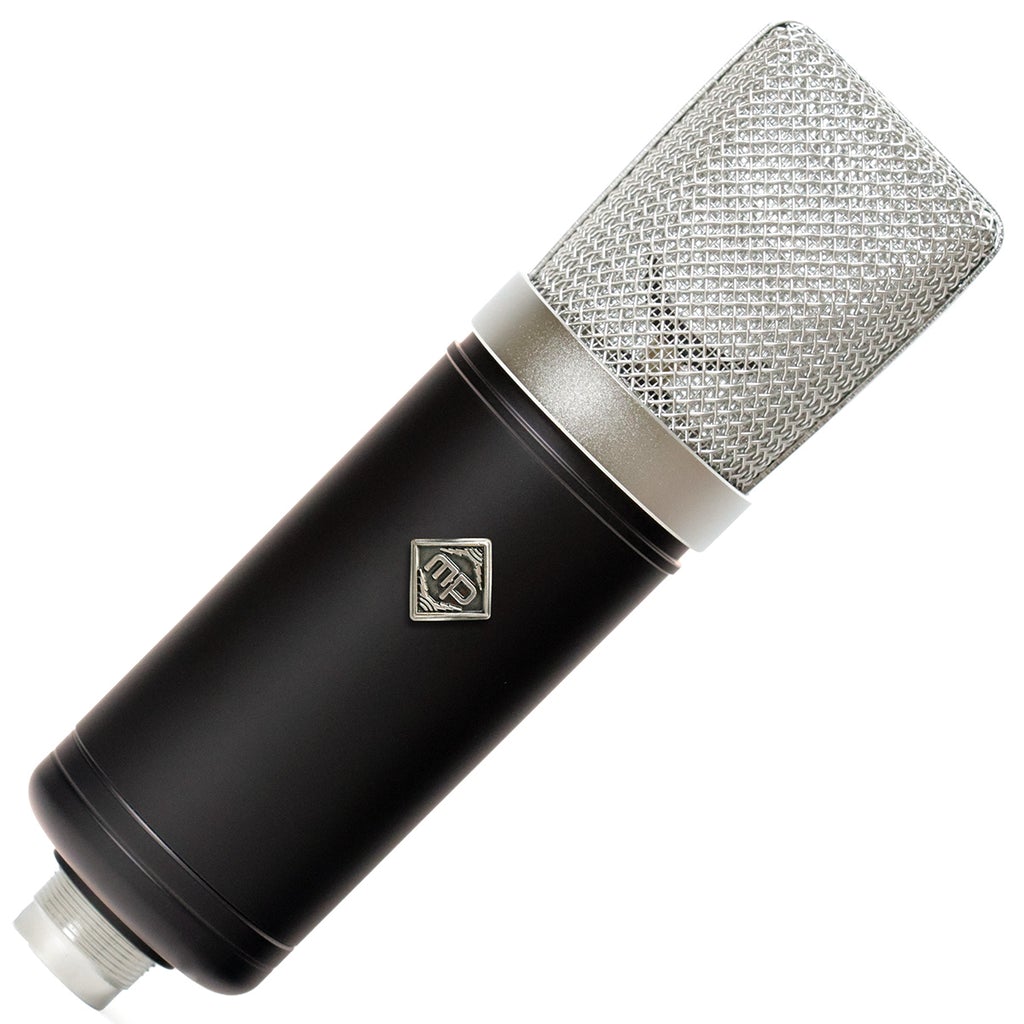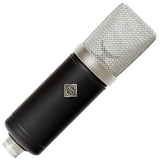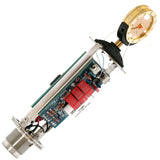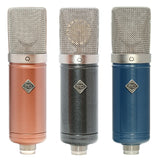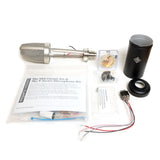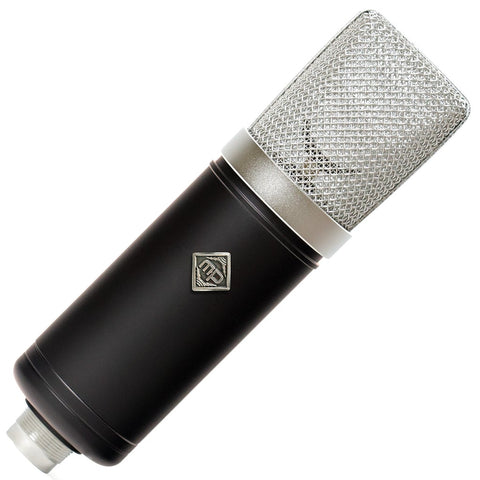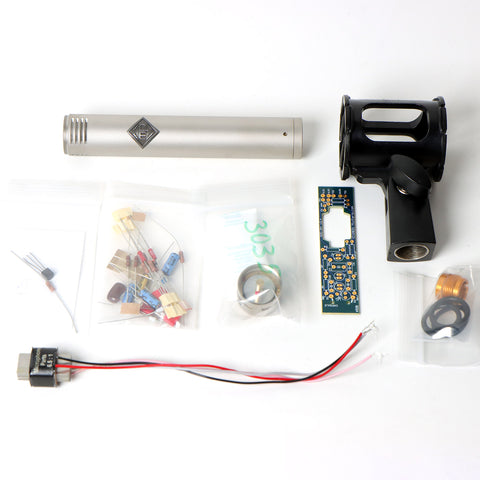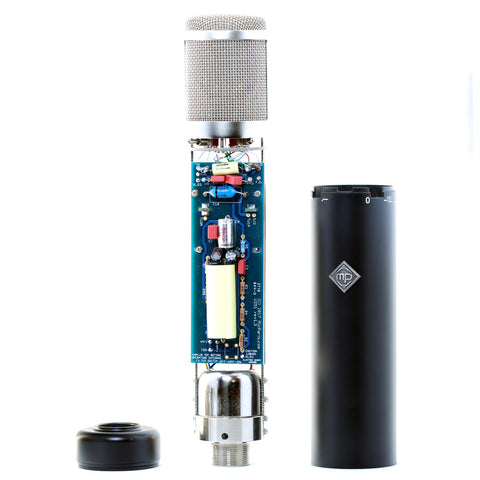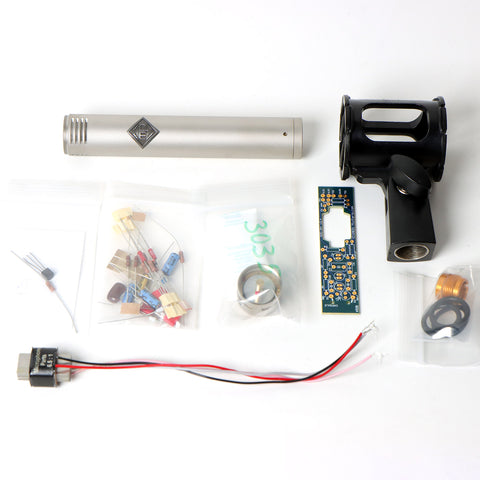T-47 Microphone Kit
$ 419.00
T-47 Mic Kit At A Glance
- Vintage circuit design: single-stage JFET with custom-wound transformer
- Two switches (internal): Pattern (Cardioid/Omni) and pad
- Solid brass 34mm K47-style capsule
- MicParts-branded mic body (custom powdercoat color options available too)
- Excellent DIY instruction manual
- Swivel mount and zipper storage pouch
Applications
- Vocals
- Acoustic guitar (especially thin-sounding, brightly voiced, or small-body guitars that need more weight or body)
- Drum overheads (for loud players, use the internal pad)
- Acoustic bass
- Bass Cabinet
- Electric Guitar Cabinet
- Drum room
About the Circuit
We started with one of the simplest and cleanest vintage mic circuits in history, Neumann's KM84. You don't need 500 components to make a great microphone; we'd agree with Neumann engineers that the simplest solution is often the best.
We implemented the circuit without electrolytic or tantalum capacitors. We picked a vintage JFET, which we put through a rigorous selection and biasing procedure (see below). We removed the silly attenuator components that needlessly reduce output level. We found a wonderful-sounding, US-made output capacitor. And a shockingly good transformer...
About the Transformer
In a circuit with such a simple audio path -- capsule, JFET, capacitor, transformer, in that order -- every one of those components is critical. We knew the transformer would have to be something special, so we tested six of them, including models from the biggest names in audio transformers.
The best performer of the bunch was our own US-made, custom-wound 6.5:1 unit, which delivered the best combination of measured performance (read: harmonic distortion) and sound quality.
This transformer is called the "MP6.5."
JFET Selection and Biasing
Every single-stage JFET circuit has limited headroom. It's the nature of the design. It only works well if the JFET is selected and biased properly.
We always cringe when we see other DIY microphone circuit kits that gloss over this critical detail. "Adjust bias until the drain hits 10V," they say. We've put that advice through our distortion analyser. The results aren't pretty.

So, we know better than to leave JFET bias to chance. To that end, we built a fancy selection and test rig. We plug in a JFET, inject a 1kHz tone, and test the transistor for output level. Then we dial in the ideal bias point for minimum distortion. There is a very narrow range of bias values that deliver the absolute minimum distortion for any given JFET. If the device under test doesn't exhibit the necessary drop in 2nd H distortion, we reject it and start fresh with the next JFET.
For those that meet our distortion spec, we make sure we have a fixed bias resistor value in stock that is within the target range. If not, that JFET gets skipped.
Then we take it one step farther...
Harmonic Coloration Option
 Once we've found the ideal low-distortion point for every JFET, we supply a second, alternate bias resistor, selected to add 10–12dB of 2nd harmonic content. Although this runs contrary to everything we believe a well-designed microphone circuits should do, we'd rather give engineers the choice. If you're building a mic primarily for vocal use, and you want to experiment with a bit higher 2nd Harmonic content to give more weight to the tracks, build your mic with this alternate bias resistor.
Once we've found the ideal low-distortion point for every JFET, we supply a second, alternate bias resistor, selected to add 10–12dB of 2nd harmonic content. Although this runs contrary to everything we believe a well-designed microphone circuits should do, we'd rather give engineers the choice. If you're building a mic primarily for vocal use, and you want to experiment with a bit higher 2nd Harmonic content to give more weight to the tracks, build your mic with this alternate bias resistor.
Visual Color Choices
The standard T-47 kit comes with an aluminum microphone body with a matte black painted finish and vintage diamond MicParts logo badge.
Alternatively, you can choose a custom powdercoated color; see the options here.
The grille, for all body color options, is a 2-layer brass mesh with satin nickel finish.
About the Body (and switches)
The body has no external switches. This microphone has two internal switches, one for pattern (C/O) and one for pad. To access the switches, spin the end cap off of the bottom of the mic, and slide the body sleeve down.
It is best to unplug the mic from phantom power before opening the mic.
S-47 vs. T-47
What's the difference between our S-series (Schoeps style) RK-47 mic kit and the T-series (KM84 style) RK-47 mic kit?
Both have high sensitivity -- higher than most commercial microphones. Both have very low self-noise.
Both mics have an internal Cardioid/Omni switch. In the S-series, the pattern switch can optionally be built as a pad switch instead. In the T-series mic, the pad switch is separate (that is, the mic has 2 switches that can be used independently.)
The S-47 uses a 2-stage transformerless circuit that is very pure and uncolored. The T-47 uses a single-stage transformer circuit that will exhibit overload characteristics when pushed -- as is true of all vintage mics with transformers. That is in fact one of the reasons vintage microphones have such an appealing sound.
In terms of the build experience, the T-47 is easier to build than the S-47, simply because there are only half as many components.
Included
- Mic body, chassis, grille, and PCB mounting screws
- Swivel mount
- Zippered vinyl pouch
- Two custom PCBs, with 100% of circuit components needed to complete the circuit
- RK-47 capsule, supersaddle, screws, and wires
- Custom-wound transformer with high nickel lamination
- Comprehensive step-by-step DIY installation guide
- Tech support via email
The Ask Audio Review
 The T-47 kit was reviewed by Ask Audio. The reviewer put it up against a vintage Neumann microphone in the studio and remarked that "it was extremely difficult to tell the difference."
The T-47 kit was reviewed by Ask Audio. The reviewer put it up against a vintage Neumann microphone in the studio and remarked that "it was extremely difficult to tell the difference."
Read the full review here.
Recommended Shockmount
We recommend the Roswell Pro Audio "Cutaway™" shockmount, available exclusively here.
Can't DIY? We'll build it for you!
If you're not interested in building this kit yourself, we can build the microphone for you. See our finished T-47 microphone -- hand-built to order in California (usually ships within 7 days).

